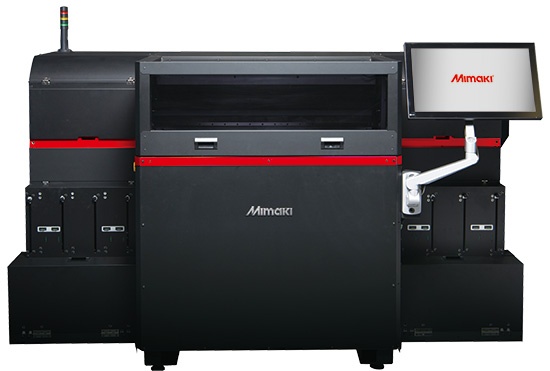Created by the Fraunhofer Institute for Computer Graphics Research IGD (Germany) as advanced slicer software meant to control a variety of different hardware, Cuttlefish is a 3D printer driver that allows users to create complex, color prints. Now 3D printer manufacturer Mimaki--headquartered in Atlanta–is integrating Cuttlefish into their 3DUJ-553 systems, expanding their interfaces further, and giving access to even more users in need of the advantages of a universal printer driver.
 The Cuttlefish driver is a unique innovation for 3D printers that not only translates data for both 3D scans and 3D models created by design software, but also offers a wide range of features to include:
The Cuttlefish driver is a unique innovation for 3D printers that not only translates data for both 3D scans and 3D models created by design software, but also offers a wide range of features to include:
- Support of Stratasys Polyjet 3D printers also
- Ability to use multiple materials at the same time
- Exact reproduction of geometry
- Reproduction of colors and fine color transitions
- Simulation of the finished product on screen

(Image: Cuttlefish)
The Cuttlefish software is highly adaptable, also offering a calibrated color profile and translucency. The ability to switch between printers is made easy for users also:
“The combination of 3DUJ-553 and Cuttlefish will greatly expand the possibilities of full color 3D printing, which is something we will continue to support,” said Mimaki’s General Manager of 3D Project Research and Development, Masakatsu Okawa, in explaining the decision to open the interfaces to Fraunhofer IGD, while providing color value continuity, translucent design processing, and geometric accuracy.
RGBA textures (red, breen, blue, and alpha channels) are supported by Cuttlefish, with color and translucency data from opaque in color to completely transparent—allowing for seamless printing with transparent materials.
The versatile and multi-faceted driver also allows users to create numerous models that are overlapping, making note of how ‘an object scatters light,’ along with changes in both color and surface due to lighting variations. In emphasizing the potential for the use of Cuttlefish not only in industrial venues overall but specific applications like medicine, the driver was used to make a medical model sample demonstrating anatomy, made up of 28 parts overall.
“Transparent parts of the model were generated by simply modifying the RGBA data. 3D models based on RGBA data are supported by standard 3D file formats and most design and texturing tools. Even established image processing programs such as Adobe Photoshop can work with RGBA textures. This makes Cuttlefish an all-purpose tool in professional 3D printing that closes the gap in quality between virtual design and its reproduction as a 3D print,” stated the two companies in a recent press release sent to 3DPrint.com.
Below are specs on the Mimaki 3DUJ-553 3D printer:
- Photorealistic output with over 10 million colors and a true ICC color profile workflow
- Water-soluble support material for quick and simple model finishing
- 20 Micron minimum layer thickness
- Large 20″ x 20″ x 12″ (500 x 500 x 300mm) build area
- CMYK, White, and Clear inks
- Mix Clear and CMYK inks to achieve transparent color effects
The Fraunhofer ILT is a massive and dynamic organization. Today, Fraunhofer ILT serves as a part of the Fraunhofer-Gesellschaft—comprised of over 26,600 employees, 72 institutes, and an impressive budget of 2.6 billion euros.
Over time we have reported on their progress from 3D screen printing of metals to development of new 3D printers, materials, and more—as well as other companies that have used their Cuttlefish driver, like Laika Studio.
What do you think of this news? Let us know your thoughts! Join the discussion of this and other 3D printing topics at 3DPrintBoard.com.
[Source / Images: Fraunhofer IGD/Mimaki]Subscribe to Our Email Newsletter
Stay up-to-date on all the latest news from the 3D printing industry and receive information and offers from third party vendors.
You May Also Like
Initial Speakers and Sponsors Announced for Additive Manufacturing Strategies 2025
Nearly a year away from the event, the Additive Manufacturing Strategies (AMS) 2025 conference is already beginning to take shape. Building upon the success of 2024’s summit, AMS has established...
EOS & AMCM Join Forces with University of Wolverhampton to Establish UK Centre of Excellence for Additive Manufacturing
German additive manufacturing (AM) powerhouses EOS and AMCM will partner with the UK’s University of Wolverhampton, home of the Elite Centre for Manufacturing Skills (ECMS), to establish the UK Centre...
Bryson DeChambeau Lobs New Brand Avonda into the Green with 3D Printed Golf Clubs
Scottie Scheffler won the Masters, but Bryson DeChambeau also made an impressive showing, demonstrating remarkable skills that led him to a tied-for-sixth-place finish. Known as “the Scientist” for his exhaustive...
Why Corrosive Resistant Materials Are Important to the Success of 3D Printing Across Industries
The adoption of additive manufacturing (AM) is accelerating across many major industries. As this technological shift unfolds, the importance of corrosion resistance has emerged as a challenge for 3D printing...

































